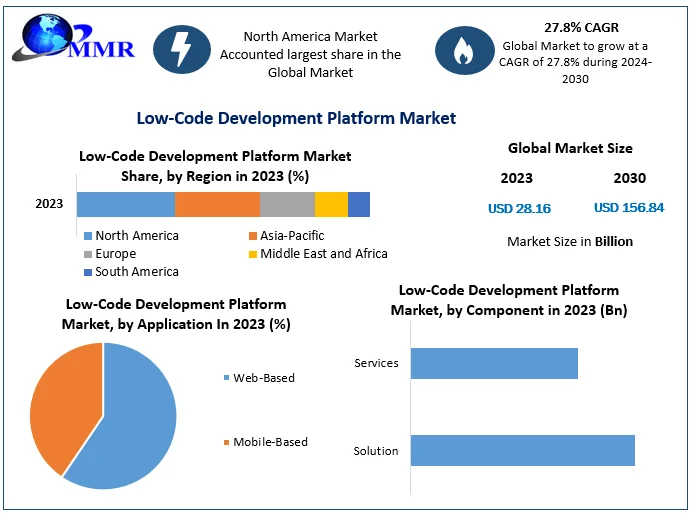Recommended Info For Choosing Low-Code Platform Recommendations
Recommended Info For Choosing Low-Code Platform Recommendations
Blog Article
Speed-Wise, Low-Code Applications Offer Many Advantages.
Visual Development Environment :
Drag-and-Drop Interfaces: Low-code platforms provide visual tools for designing applications. Drag-and-drop tools let developers quickly create applications without having to write lengthy code.
Pre-built Components and Templates: A lot of platforms that allow low-code support come with templates and components that are pre-built, allowing developers to prototype quickly and create applications without having to start completely from the beginning.
Reduced Coding Requirements:
Automated code generation: Low-code systems generate the underlying codes based on visual models created and maintained by programmers. This eliminates manual coding and speeds up the process of development.
Reusable Parts Developers will have the ability to reuse reusable components across their projects, thereby reducing the time needed for writing and testing of code.
Collaboration streamlined:
Low-code platform tools typically contain versions control, testing deployment. This allows for the seamless communication between teams.
Citizen Development Developers, business users and other stakeholders are able to help in the creation of applications by using user-friendly interfaces. This reduces the bottleneck caused by inaccessibility of professional developers.
Rapid Iteration and Prototyping
Rapid prototyping: Developers are able to quickly build prototypes that can be used to test ideas and get feedback, leading to faster the cycle of iterations.
Easy Modifications: Low-code design is visual-oriented, making it easier to change and upgrade applications. It helps speed up the process for refining and optimizing applications based on feedback from users.
Pre-built Integrations:
API Integrations. Low-code platforms usually include pre-built connectors and APIs for the most popular services, which reduces the amount of time required to integrate other systems.
Data Integration: Built-in tools to integrate data facilitate the connection between databases and data sources. This helps speed up development.
Deployment, scaling and deployment:
A lot of low-code platforms offer one-click options for deployment which can reduce the amount of time and effort required to set up applications.
Cloud-based solution: Cloud based low code platforms are able to handle the management of infrastructure and scale. This allows developers to focus more on applications' logic, functions and features rather than the logistics of deployment.
Low-code application development is a more efficient method to develop applications. It simplifies and automates many aspects of the procedure. This makes it easier to speed up development and the ability to adapt to changing requirements. Read the top my review here for Low-code Platform for application development for more advice including application development platforms, application modernization, build with docker, sso azure, build a docker container, app modernisation, develop web app, azure sql, mobile app development platforms, mobile development platforms and more.
The Cost-Effectiveness Of Low-Code Development Is One Of The Primary Benefits.
Low-code apps offer many advantages, such as cost-effectiveness. This is a great alternative for companies looking to reduce development costs without sacrificing quality. Here are some of the most important benefits:
Lower requirements for coding: Low codes platforms remove the need for lengthy hand-coded apps. Developers can take less time and energy developing apps. It also means lower costs for labor.
Lower Developer Resources: As low-code is more efficient and less time to develop, less specialized developers will be required. It could reduce the costs of staffing and hiring.
Speedier time to market
Accelerated development cycles: Visual development tools as well as prebuilt components that are provided by low-code platforms allow rapid application development. This allows companies to bring their products market quicker. This could result in faster revenue generation and improved position in the marketplace.
Rapid prototyping: By constructing and testing prototypes quickly companies can cut down on the time they devote to the process of development and enable faster iterations based on user feedback.
Reduce Maintenance Costs
The modular architecture and standardized components of apps developed using low-code platforms makes them simpler to maintain. It helps reduce costs for maintenance and support.
Automated Updates. Many low-code platform handle updates and patch automatically. Applications remain safe without needing extensive manual input.
Efficient Resource Utilization:
Low-code platform contributions let both business users and other non-developers participate in the creation process. This allows businesses and employees to collaborate, thereby reducing dependence on developers who earn high salaries.
Optimized use of IT resources IT departments are given the chance to concentrate on more strategic initiatives, instead of being sucked into routine work tasks for development. Overall productivity and efficiency improves.
Pricing models that can be scaled:
Subscription-Based Pricing: A lot of lowcode platforms have flexible, subscription-based pricing models that grow in line with usage. This lets businesses align their expenditure with their real needs and growth.
Pay-As-You-Go options Certain platforms allow companies to pay for only what they use. This is especially beneficial for small or start-up companies with limited funds.
Reduce the cost of Third-Party software:
Low-code platforms typically come with integrated functions that eliminate the requirement to purchase additional tools or software. This can save you money on subscriptions and software licensing costs.
Pre-Built Integrations with popular systems and services it can save you time and money by not having the need to develop custom integrations.
Higher ROI
A faster return on investment: Rapid development and lower costs, coupled with speedier time to market will allow businesses to earn higher return on their investment.
Enhanced Agility - Businesses can quickly adapt to changes in the market and the changing needs of customers. This lets them stay relevant and to take advantage of opportunities that come up.
Lower Cost of Training
User-Friendly Interfaces: The nimble user-friendly interfaces on low-code platforms cut down on the learning curve for new users, eliminating the need for lengthy training programs.
Accessible Resources Low-Code Platforms: Many low-code platforms have extensive training materials, tutorials, as well as community support, cutting the need for formal training and associated expenses.
Streamlined Collaboration:
Improved Collaboration Tool: The built-in collaboration tool helps improve communication and cooperation among team members. This leads to faster development processes and reduces project overhead.
Unified Development Environment (UDE): An unified, single development environment simplifies workflows, reducing the costs and complexity of managing multiple platforms and tools.
In general, applications that use low-code cost less due to their ability to reduce costs for maintenance and development and to speed up time-to-market to maximize resource use and also to offer flexible pricing. The combination of these factors can provide firms significant financial benefits which makes Low-code a desirable option for companies seeking to maximize development budgets, yet still creating robust and flexible applications. View the best Enterprise application development with Low-code Platform blog for site examples including stored sql procedures, azure sql, driver jdbc, cross platform app development, application development platforms, app modernization, multiplatform mobile app development, application development platforms, push alerts, rapid action development and more.
Benefits Of Low-Code App Development In Terms Of Limitations And Customization
Low-code design for applications is a flexible, balanced approach that takes into account limitations and allows for customization. Here are a few major advantages: Handling limitations
In overcoming Complexity Barriers:
Simplified Development : Low-code platform simplifies development by providing components and templates that are pre-built, allowing to speed up creation and deployment.
Many platforms have wizards and guided workflows to help developers navigate complicated processes. These tools minimize the chances of errors, and ensure the consistency of.
Scalability Solutions
Scalability Built-In Lowcode platforms typically include features to support an scalable architecture. They permit applications to handle growing loads without major redevelopment.
Performance Monitoring: Tools that monitor and optimize performance can help ensure that the applications are effective even as they expand.
Security and Compliance
Security features integrated into Low-code platform come with built-in measures of security, such as encryption. Access control that is based on roles and automated compliance check, addressing the most common security issues.
Platforms are regularly updating their security protocols and methods of compliance, which ensures that applications are safe from new threats.
Customization Features:
Extensibility:
Low-code platforms allow custom code Platforms that allow the integration and the use of customized code.
Developers are able to add customized modules or plugins to meet specific business needs.
APIs and Integration
API Support: A comprehensive support for APIs enables seamless integration with external systems and services. This allows for extensive customization and connectivity.
Third-Party Platforms Lowcode platforms are usually already built with connectors to third-party apps, making it easier to integrate these applications and personalize the application.
Flexible UI/UX Design:
User-friendly interfaces that can be customized: Users are able to modify and create their own user interfaces, which can provide an experience that is more customized.
Responsive Web Design Responsive Web Design: Built-in design responsive capabilities allow applications to be customized according to the device and screen size.
Custom Business Logic for Businesses:
Visual Workflow Builds: Visual tools that permit customization of workflows as well as business rules, and also to create complex custom processes.
Conditional Logic & Scripting: Platforms allow the use of conditional logic, and custom scripting for handling specific business rules.
Data Management
Custom Data models: Developers are able to design a custom data model that meet the specific requirements of an application, and ensure that data handling complies with business needs.
Advanced Data processing: Integration and advanced data handling tools allow for the customisation of data analysis and use within the application.
Balancing Customization with Limitations
Frameworks and Standards:
Low-code Platforms Support Industry Best Practices and Standards: Low-code platforms encourage adherence to the industry's best standards and practices. This helps to maintain high-quality, secure and scalable applications.
Governance Frameworks - Built-in governance systems ensure that customisations do not compromise security, integrity or the observance of regulations.
Iterative Development & Feedback
Rapid prototyping: Through being able to rapidly prototype and test customizations, developers are able to iterate on feedback from users to improve the functionality of the application.
Low-code platforms are designed to support continual advancement. This permits customizations and improvements as requirements for business change.
User Empowerment:
Giving Citizen Developers the tools they need: Low-code platforms boost the number of developers who are capable of improving and customizing applications by permitting them to create custom an intuitive user interface.
Training and Support - Many platforms provide extensive training and resources to support users in the process of customizing their applications, without compromising its stability or performance.
Low-code development is an effective framework that permits a lot of flexibility while also addressing limitations. This allows businesses to create and maintain apps that are tailored and functional to meet their particular requirements, while maintaining high standards of safety, quality, and scaling.